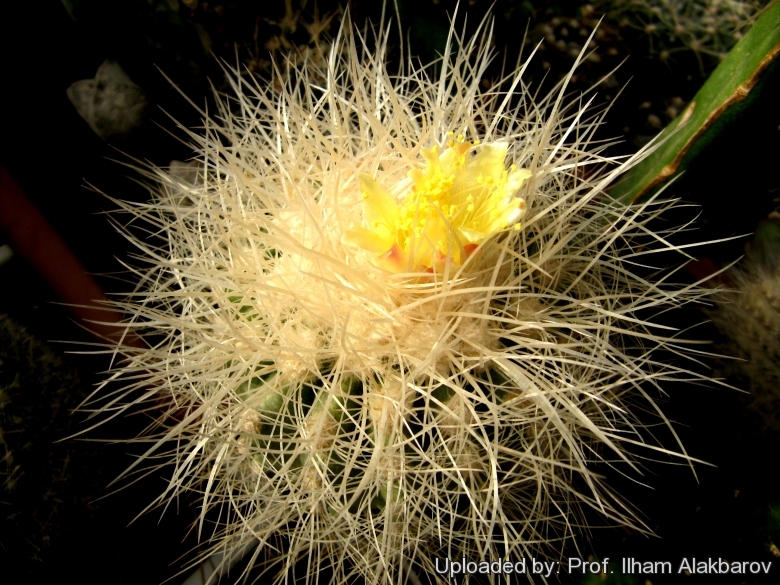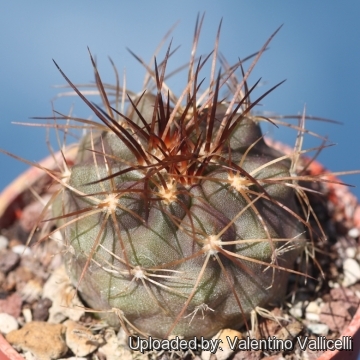Accepted Scientific Name: Copiapoa krainziana F.Ritter
Taxon 12: 30 1963

Copiapoa krainziana var. scopulina Photo by: Prof. Ilham Alakbarov
Origin and Habitat: Copiapoa krainzianaSN|1380]]SN|1386]] var. scopulina is endemic to a very small area in Chile, II Region Atacama desert, Antofagasta, north of Taltal, coastal mountains.
Altitude: Around 500-600 metres above sea level.
Habitat: This species strives fully exposed to the sun in extremely dry areas with very rare rainfall, on coastal hills (lomas costeras) and canyons on plains and on slopes facing north. They often grows mingled with clumps of Copiapoa cinereaSN|1386]]SN|1380]] f. haseltoniana and columnar Eulychnia. The dry season lasts 8-12 months and in some years it is possible to have no rainfall at all. Rainfall less than 100 mm/year. The plants obtain water mainly from condensation of coastal fog (camanchaca). By the middle of the morning however, the fog cover dissipate and sun breaking through the gaps warming the ground. Special attention needs to be paid to illegal collection because it is a very attractive species, even though pressure on the wild population has been reduced through seed availability and propagation of individuals through cultivation.
Synonyms:
See all synonyms of Copiapoa krainziana
back
Accepted name in llifle Database:Copiapoa krainziana F.RitterTaxon 12: 30 1963Synonymy: 6
back
Description: Copiapoa krainzianaSN|1386]]SN|1386]] var. scopulina (often listed as Copiapoa scopulinaSN|9813]]SN|9813]]) is a beautiful and popular species very similar, possibly only a variety of Copiapoa krainzianaSN|1386]]SN|1386]]. It distinguish for having only 10-20 thin spines, however there is so much variation in spination that most authors choose to lump them together.
Habit: Solitary or forming large clumps up to 1 m wide densely covered by spines.
Stems: Globose to cylindrical usually grey to green in hue, up to 12 cm wide with a woolly crown.
Ribs: 13 to 24 ribs, straight.
Areoles: Large, roundish, with grey wool.
Spines: 10-20, densely distributed, needle-like, long, very thin, straight or curved, flexible usually white or greyish, occasionally brownish.
Flowers: Clear yellow, 3,5 cm long.
Fruits: White or rose, up to 1 cm long.
Subspecies, varieties, forms and cultivars of plants belonging to the Copiapoa krainziana group
Bibliography: Major references and further lectures
1) Saldivia, P., Guerrero, P., Faundez, L. & Walter, H.E. 2013. Copiapoa krainziana. In: IUCN 2013. IUCN Red List of Threatened Species. Version 2013.2. <www.iucnredlist.org>. Downloaded on 16 February 2014.
2) Edward Anderson “The Cactus family” Timber Press, Incorporated, 2001
3) James Cullen, Sabina G. Knees, H. Suzanne Cubey "The European Garden Flora Flowering Plants: A Manual for the Identification of Plants Cultivated in Europe, Both Out-of-Doors and Under Glass" Cambridge University Press, 11/Aug/2011
4) David R Hunt; Nigel P Taylor; Graham Charles; International Cactaceae Systematics Group. "The New Cactus Lexicon" dh books, 2006
5) A. Hoffmann, H. Walter “Cactáceas en la flora Silvestre de Chile” Ediciones Fundacion Claudio Gay, Santiago, Chile. Second Edition. 2004
6) G. Charles “Copiapoa. The Cactus file Handbook 4” Cirio Publ. 1998
7) R. Schulz and A. Kapitany “Copiapoa in their environment” Schulz Publishing, Teesdale, Australia. 1996
 Brown spines form. Photo by: Valentino Vallicelli
Brown spines form. Photo by: Valentino VallicelliSend a photo of this plant.The gallery now contains thousands of pictures, however it is possible to do even more. We are, of course, seeking photos of species not yet shown in the gallery but not only that, we are also looking for better pictures than those already present.
Read More... Cultivation and Propagation: This slow growing cactus is kept for the beauty of its form and spines. It must be protected from excessive heat and sun in summer, and seems to do best in cultivation with a bit of shade. It requires light but regular watering in summer, but let the soil mix dry between watering, Prone to rot if over-watered. Needs good drainage. Keep warm and dry in winter (10°C) to avoid rot. Not highly tolerant of a great deal of frost. (Frost tolerance 0°C)
Propagation: Seeds (or offsets if available), Grafting is often used to speed growth rate and to create a back-up to plants in collection.












